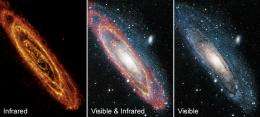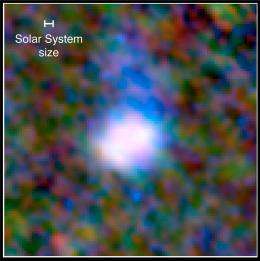Herschel spacecraft celebrates one year of spectacular science

The World's largest space telescope, ESA’s Herschel Space Observatory, is celebrating one year of spectacular science. A meeting at the Royal Astronomical Society in London is showcasing some of the latest groundbreaking research.
Herschel is a far-infrared telescope, and its three scientific instruments detect light with a wavelength typically several hundred times longer than the visible light that we see. Instead of seeing stars, this allows Herschel to observe gas and dust between the stars. Herschel is a flagship mission of the UK Space Agency, which funds the UK's involvement in the UK-led SPIRE instrument.
Herschel is observing objects in our galaxy and beyond, in an effort to understand when the first stars formed, how galaxies evolved into those we see around us today, and how planets form. Prof Derek Ward-Thompson, Cardiff University, one of the organisers of the meeting, said “This represents an opportunity to showcase the work taking place with Herschel data here in the UK. We are grateful to the RAS for hosting us, and I look forward to hearing about the latest developments.”
Far-infrared images are often complementary to images at other wavelengths. This is demonstrated admirably by the recently released image of the Andromeda galaxy. Andromeda is as close as we can get to a twin of our own Milky Way, with the two being the largest members of the Local Group of galaxies. At a relatively close 2.5 million light years, astronomers can study Andromeda in much greater detail than other more distant galaxies.

The optical light traces the stars in the spiral arms, tilted over with respect to our view from Earth, and laced with dark dust lanes. When seen by Herschel the stars are not shown, but instead the dust itself is glowing, with the brightest areas being those regions which are warmed by stars forming within. “These two images demonstrate very clearly how observations in different parts of the spectrum complement each other. While in the optical we see mainly the older stars, in the far-infrared we see dust which traces the gas where new stars are forming.” said the Herschel Project Scientist Göran Pilbratt from ESA.
The proximity of Andromeda allows astronomers to study features which are, ironically, very hard to observe in our own galaxy, due to having to look through the entire disc of the Milky Way. It is also useful for bridging the gap between observations of dust and gas in the Milky Way, and those of much more distant galaxies.
The Virgo Cluster of galaxies comprises around two thousand individual galaxies, and lies around fifty million light years away. By observing large areas in and around the Virgo Cluster, astronomers will use the Herschel images to study galaxies of all shapes and sizes and in a range of environments. One particular galaxy, Messier 61, is one of the largest in the cluster, around the same size as the Milky Way.
In the Herschel image, Messier 61 is not alone, with four much fainter objects visible close by. Two of them are much smaller galaxies which are orbiting Messier 61, not unlike the Magellanic Clouds which orbit the Milky Way. A third galaxy may be in a similar situation, while the fourth is merely a background galaxy. Dr Jonathan Davies, Cardiff University, who leads the “HeViCS” project which is studying the Virgo cluster, said “Virgo represents an excellent opportunity to investigate how a large cluster of thousands of galaxies can influence how any one individual galaxy evolves and changes with time. This will give us a better insight into how galaxies form and how many of them evolve into the beautiful spiral structures we see today, as typified by Messier 61.”
One of the main advantages of Herschel is that it can see objects of a huge range of physical sizes. As the most powerful far-infrared telescope ever built, Herschel can see the late stages of the formation of planetary systems like our own Solar System. A new image of a star called Eta Corvi shows not the star itself, but a huge belt surrounding it about four times the size of the Solar System's Kuiper belt.
Our own Kuiper Belt lies beyond the orbit of Neptune and contains objects of a range of sizes, including the dwarf planets Pluto and Eris. Eta Corvi’s belt is similar, made up of icy objects ranging in size from micron-sized grains to comets many kilometres in diameter. This image was taken as part of a survey of nearby stars by the DEBRIS Collaboration, an international team of astronomers, including Dr Jane Greaves from the University of St Andrews and Dr Grant Kennedy, from the University of Cambridge, who will be presenting this work to the RAS.
This remarkable system is also home to a second, brighter dust ring much closer to the star, so close that the dust is about the temperature of boiling water. While Herschel can’t see the dust disc in detail, other observations have proved its existence. The best explanation for its existence is that comets are currently being scattered in from the large outer belt by planets.
"A system with both hot and cold dust like Eta Corvi is very rare, and gives us something we can compare with important aspects of our Solar System’s formation” said Laura Churcher, a PhD student at the Institute of Astronomy, University of Cambridge. It is thought that a similar process in our own Solar System nearly 4 billion years ago resulted in a spike in comet impacts on the Earth and Moon.
The research topics being presented at the Royal Astronomical Society are a few highlights of the research taking place using Herschel data. Dr David Clements, Imperial College London, and co-organiser of the meeting, said “it’s fantastic to see so many interesting things being done with Herschel data. The UK is a true world leader in this kind of astronomy, from instrument building to doing the science with the observations and the theoretical work behind it all. The breadth and depth of what we’re seeing at this RAS meeting just re-emphasises that point.”
Provided by UK Space Agency



















